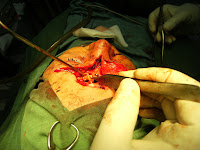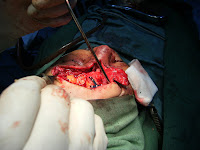

 intraoprative data:
intraoprative data:In this case of frantal fracture , exploration for dural and repair was done.






The anterior table can be reposioned and fixed by miniplate and scrow.







Treatment Options for fractures of the posterior table
Ø Nondisplaced without CSF leak
Observation
Ø Nondisplaced with CSF leak
Conservative management of CSF leak with progression to sinus exploration if no resolution in 4–7 days
Ø Displaced (>one table width)
Sinus exploration, repair of dura, obliteration or cranialization depending on involvement of the posterior table.
Ø Involvement of the nasofrontal outflow tract
Obliteration or~and cranialization









































